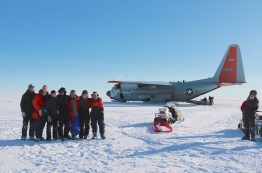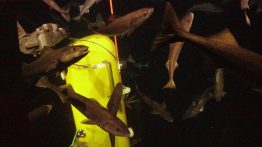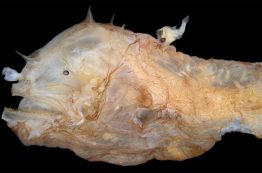Nature is full of repeating patterns that are part of the beauty of our world. An international team, including a researcher from the University of Washington, used modern tools to explain repeating patterns of stones that form in cold landscapes. The new study, published Oct. 5 in the Proceedings of the National Academy of Sciences, uses experimental tools to show how needles of ice growing randomly on frozen ground can gradually move rocks into regular, repeating patterns.
Read more at UW News »South Pole and East Antarctica warmer than previously thought during last ice age, two studies show
The South Pole and the rest of East Antarctica is cold now and was even more frigid during the most recent ice age around 20,000 years ago — but not quite as cold as previously believed. University of Washington glaciologists are co-authors on two papers that analyzed Antarctic ice cores to understand the continent’s air temperatures during the most recent glacial period.
Read more at UW News »NSF-funded deep ice core to be drilled at Hercules Dome, Antarctica
Antarctica’s next deep ice core, drilling down to ice from 130,000 years ago, will be carried out by a multi-institutional U.S. team at Hercules Dome, a location hundreds of miles from today’s coastline and a promising site to provide key evidence about the possible last collapse of the West Antarctic Ice Sheet. The National Science Foundation has funded the roughly five-year, $3 million project involving the University of Washington, the University of New Hampshire, the University of California, Irvine and the University of Minnesota.
Read more at UW News »Big ships and underwater robots: heading out to sea with the Ocean Observatories Initiative
It’s summertime, and that means scientists across the University of Washington College of the Environment are in the field collecting data. Researchers in the School of Oceanography are no different and are working off the Oregon coast on their annual expedition to maintain the long-running cabled ocean observatory. Part of the broader National Science Foundation’s Ocean Observatories Initiative (OOI), UW oversees the Regional Cabled Observatory that spans several sites in Pacific Northwest waters, ranging from shallow coastal locales to deeper waters in the open ocean more than 300 miles offshore.
Read more »Deep-sea anglerfishes have evolved a new type of immune system
Deep-sea anglerfishes employ an incredible reproductive strategy. Tiny dwarfed males become permanently attached to relatively gigantic females, fuse their tissues and then establish a common blood circulation. In this way, the male becomes entirely dependent on the female for nutrient supply, like a developing fetus in the womb of a mother or a donated organ in a transplant patient. In anglerfishes, this unusual phenomenon is called “sexual parasitism” and contributes to the reproductive success of these animals living in the vast space of the deep sea, where females and males otherwise rarely meet.
Read more at UW News »





